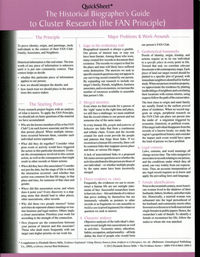
|
|
|
| Product Information: | ||
| Details: | QuickSheet: The Historical Biographer’s Guide to Cluster Research (the FAN Principle); by Elizabeth Shown Mills; Published 2012; ; 4 pp folded sheet, 8.5x11; laminated; ISBN: 9780806318943; Item # GPC3868 In this QuickSheet Elizabeth Mills introduces us to the concept of “Cluster Research” based on the FAN principle, the idea being that to prove identity, origin, and parentage individuals must be studied in the context of their FAN club--family, associates, and neighbors. Historical information, she says, is like real estate: the true value of any piece of information is unknown until it is put into community context. To apply the FAN principle in order to establish a set of facts concerning identity, parentage, and origin, several questions must be asked: Who are the known members of the FAN club? What did they do together? When did they have this association? Where did this association occur? And why did these people interact? Since most individuals left comparatively few records, the answers we seek to specific research questions may not appear in any surviving record, but by expanding our research to include family, friends, neighbors, and associates we increase the number of resources available to assemble a historical biography. Illustrated by a bull’s eye, targeted research using the FAN principle starts with the targeted person, then works outward to known relatives and in-laws, to others of the same surname, to associates and neighbors, and ultimately to associates of those associates, piling up details in ever-widening rings to cover all members of the target’s circle of acquaintances. As the bull’s eye illustrates, the core target is relatively small, but as we move outward, the target enlarges, the range of possible discoveries greatly expands, and the amount of time needed to cover all possibilities also increases. In the end, where direct evidence is usually lacking, we fall back on family, associates, and neighbors to reconstruct a life and create a historical biography. With the rules laid down in this QuickSheet we have the tools to test prior assumptions, analyze new findings, and ultimately prove identity, origin, and parentage. ContentsThe PrincipleThe Starting Point Major Problems & Work-Arounds
The Problem-Solving Spiral Targeted Research Using the FAN Principle "The Historical Biographer’s Gide to Cluster Research" Book Review
|
|

